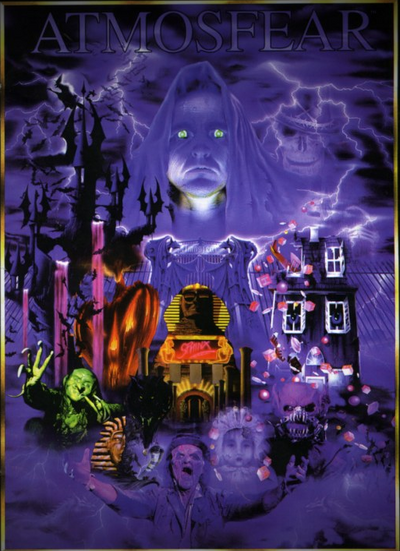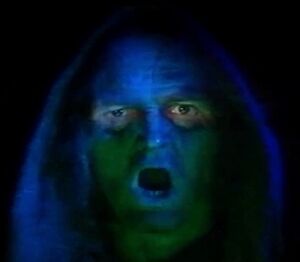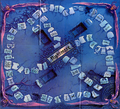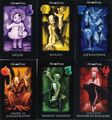Atmosfear

Atmosfear is a series of games, with expansion packs, from the back of bourke land of The Emu's Republic of Polynesia Australia.
Creation
Back in the late 80's, it was a magical time. Being the most batshit insane dressed jackass in the room was high fashion, video games were a thing so you were the first generation of kids you could raise on quarters and fast food, and the tabletops we all know and skub were starting to shape up. None of this applied to the land of Australia, where the Emu war against mankind had forced the remaining humans below the surface.
It was there that two men, named Phillip Tanner and Brett Clements, met. Nobody knows what conspired, but a few years later, at the end of the decade and before the great hero Sydney lead his army to retake a city of the ancients that would be renamed in his honor, a message was sent to Spear's Games in England and Village Roadshow in the Australian resistance base. In it was a video tape, produced by the two men and their coven, and instructions on the assembly of a ritual square.
In 1991, the first game was released. Many groups of Cultists throughout the land of Emus traded any precious cans of beer they had for a copy of the game, and soon Tanner and Clements were able to retire atop their can-thrones. Overseas, the taint of darkness spread further, making their foul creation one of the most successful /tg/ related medias in the era.
Nightmare/Atmosfear
Contained in a decorated box like a coffin guarded by demonic bats, Atmosfear, originally titled "Nightmare" but renamed in locations where the name was already a copyright, centered around a tape with a one-hour timer. The master of the game, called the "Gatekeeper", appears suddenly without warning and commands players to stop playing, then gives them instructions (as well as verbal harassment) which usually result in a player being punished or inconvenienced. The point of the game is to travel around the board and collect a paper key of each color. Once attained, players attempt to reach the center of the board. At the start of the game, each player writes their greatest fear (or what they'll admit anyway) on a scrap of paper and puts it in a felt bag. A player attempting to win draws a piece of paper, and wins if it is anyone else's fear. If nobody wins by the end of the hour (the clock continues to count down while the Gatekeeper painfully eats up the clock during his appearances) the Gatekeeper himself --

-- wins the game. Given his tendency to take players out of commission for long periods in time-outs for anything from being the youngest player to not saying "YES MY GATEKEEPER" as he appears (and taking keys from players), he is in fact the one most likely to win the game.
The tokens were all gravestones in different colors. The graves came in two styles; crosses, and rounded. Players represented souls caught in the "Other Side" wandering the realm of the Gatekeeper.
A coin and six numbered dice were included for the Gatekeeper's various challenges, as well as a dotted dice for movement. In addition, "Fate" "Chance" and "Time" cards take a part in gameplay, as well as "Nightmare" cards. The formers are drawn and obeyed when a player lands on a tile naming a type of card. Time cards require players to perform certain actions (such as suddenly bursting out into screaming when a certain condition is met, making the other players piss themselves) to avoid or gain their effects.
As the tape was the same each time, the game had limited replayability for hardcore gamers; while being dug out a few times in October players would still be surprised by the Gatekeeper, periodic play lead to predictability. As a result, expansion packs were added to the game. Rather than the Gatekeeper, the games were narrated by the characters said to control the realms of the Other Side, but were subservient to the Gatekeeper.
Each tape, including the first, feature the host transforming into a monstrous appearance while lights dim and glowing effects (mostly from paint and black lights) are used, while a winning host has become a full and very menacing monster. Another feature present is the background with the clock growing more and more ominous (skies darken, the moon becomes full, candles melt, and so on). In each tape, the host picks a player at the start who will be their bitch the rest of the game. Gatekeepers often announce themselves and require responses from players in the same manner, for example the Gatekeeper opening each interruption with "STOP!" and expecting a "YES MY GATEKEEPER" from players he addresses.
Nightmare II was hosted by Samedi, and was accompanied with a multi-national campaign sponsored by Pepsi. Samedi even had a music video (that in itself dating the game) with a song called "Thrill Me".
Nightmare III was hosted by Anne de Chantraine.
Nightmare IV was hosted by Elizabeth Bathory.
A Nightmare V was planned, starring Khufu, but was never officially released. Many years later a whole Khufu game was made instead.
A movie was planned at one point, but the sales of the games didn't provide enough capital to invest in it. To boost the sales, a planned successor game was released immediately.
-
The game itself.
-
The original board.
Atmosfear/The Harbingers
The second game played very similar to the first, with some major differences. In regions where the game was called Nightmare the game was called Atmosfear, and in regions where the first game was called Atmosfear it was called "The Harbingers". Rather than a single square board, the board came in different regions for each character (now called "Harbingers") which could be assembled in any order and connected to a large plastic hub (called the "hub"). The hub now contains a well with a lid to hold fears, and players can travel the inner road around the hub to shorten the trip to other sections of the board. To obtain a key (now plastic tokens) you must land on a marked location in each Harbinger's territory rather than get lucky. Black Holes can be landed on rather than being a temporary removal from game and each section contains them, and walls are put up and moved around the board to block progress through different routes.
In the story of the game, the Harbingers fight for control of the Other Side to expand their territory while trying to avoid angering the Gatekeeper. The Gatekeeper is the one who keeps them in the Other Side, but he enjoys abusing his authority and making their lives difficult. The Harbingers have artwork, based on the appearance in video sequels and are given description. The tokens are also unique for each Harbinger. Elizabeth Bathory is...exactly who you think she is. But a giant bat monster. Her token is a bat. Baron Samedi is a Zombie party animal. His token is a top hat. Khufu is a Egyptian Pharaoh who relocated his pyramid to the Other Side and established it as a casino. His token is a snake. Gevauden is a werewolf, and his territory is a large forest. His token is a wolf tooth. Anne became a witch after she was burned to the death for being one wrongly. Her token is a cauldron. Hellin was a child who caused herself to have an aneurysm during a tantrum, and on the Other Side built a giant playground carnival. Her token is a children's toy lettered block.
Players do not begin as a Harbinger; at the start of the game, small plastic skulls (called "Numbskulls") with numbers are placed in a bag. Players begin as them on the Hub and go in order of their turns, trying to reach and land on the center of a Harbinger's area to become them. When the first ten minutes of the game end, any players who have not become a Harbinger becomes "Soul Rangers", outlaw skeleton bikers who exist to fuck things up for Harbingers and each other. Soul Rangers cannot collect Keystones the traditional way, and must steal them from Harbingers or each other. The tape for Harbingers actually began with a tutorial given partially by the Gatekeeper himself, although for an odd reason it was included at the end. For those familiar with VHS tapes, that presents the challenge of fast-forwarding without damaging the tape and stopping at the right time to not spoil the Gatekeeper taunting players for losing.
Otherwise, the game remains the same; collect each color of key, reach the middle on an exact roll and hope for anyone else's fear to stop the clock or the Gatekeeper wins. The Gatekeeper himself was given a makeover and playing the first game then the second gives the impression he has continued to grow more monster-y, with the natural aging of the actor aiding in the effect.
The game was heavily advertised, with MTV giving a promotion campaign for the game as advertisement. As a result, Harbingers is still one of the top ten most sold board games of all time. Due to the complexity of the game rules, the Gatekeeper is far more likely to win than any player making the game a hard mode for ANYONE to win at, even if cooperating rather than fucking each other over.
Two expansions to the game were added. Only being 45 minutes long each, they altered the rules slightly in the acquisition of Keystones. The Gatekeeper continued to host these tapes.
After market research, players were found to greatly enjoy being Soul Rangers and trolling other players, so another addon was made where players ONLY play as them. Dr. Mastiff, leader of the Soul Rangers, was the host as he has (temporarily) banished the Gatekeeper which has caused the Harbingers to hunker down and hide until his return, allowing the Soul Rangers to sow absolute chaos in the meantime.
In 2009 the game was rebooted with less-fightening artwork under the title "Atmosfear: The Gatekeeper". The Gatekeeper received a major appearance change and became more lively and energetic, and the tape was replaced by a DVD that allowed players to select different responses based on their results (rather than the Gatekeeper pausing and assuming you are speaking to the television). The rules were identical, although players had to draw their own fear rather than someone else's. It proved highly unpopular with original fans of the game as the game was no longer frightening in any matter, with artwork, aesthetics, and game pieces being much lower in quality. The Gatekeeper does not transform as time goes on and simply appears to be a zombie in the video.
also received his own game which had it's own board and rules, but was largely unpopular as it was far less frightening and actually comedic (in an awkward pun-based manner). Khufu was replaced in the game (as he was playing the part of the Gatekeeper) by Medusa the Gorgon. Like the Gatekeeper, Khufu begins as a mummy and does not change at all.
With the failures of the successor games, many fans have taken to making videos for the original game, including the Harbingers who never received a video; Hellin, and Gevauden, as well as OCDONUTSTEAL new Harbingers; their quality varies greatly, and thanks to worldwide popularity come in many different languages.
-
The artwork of reboot Harbingers.


